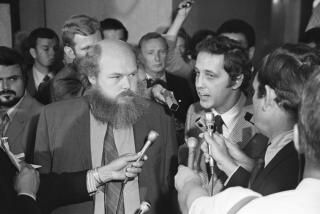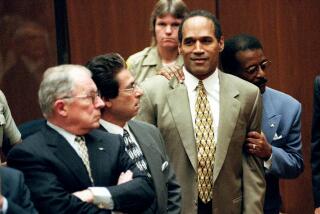Early L.A. Law : Earl Rogersâ Life In and Out of Court Was More Dramatic Than Fiction
I HAVE ALWAYS wanted to tell, if only in brief, the story of Earl Rogers, the celebrated Los Angeles criminal attorney, but I hesitated to do so as long as his daughter, Adela Rogers St. Johns, was alive. She died recently at 94.
Rogers was a genius and a drunk. In the almost 100 murder cases he pleaded, only one defendant was hanged. Most were probably guilty. When one, a man acquitted of murdering his wife, turned to Rogers after the verdict to say: âThe truth will prevail, Earl,â Rogers snarled: âGet away from me, you slimy pimp! You know youâre guilty as hell.â
Rogers was the son of a Methodist minister and an academic; he himself was steered toward the ministry, but after marriage and a baby, he came to Los Angeles in the 1890s. Fascinated by the law, he soon got into the offices of Stephen M. White, the famous attorney and U.S. senator whose statue can be found in the Civic Center today. White liked Rogersâ quick mind and his style.
The two men also had something else in common: Both were monumental drinkers. White died of alcoholism in 1901, at the age of 47. Rogers followed him along that path 21 years later, at 51.
Rogers had a bottomless capacity for knowledge as well as booze. He absorbed foreign languages; he became an expert in forensic medicine; he was up on the newly discovered science of ballistics. His cross-examinations destroyed the prosecutionâs expert witnesses. He cajoled and seduced juries with his histrionics. In person, he was immaculate. His clothes were one step beyond fashion. He always wore a gardenia in his buttonhole.
Rogersâ record of acquittals suggests that he bought witnesses. No case was ever made against him. He made more than $100,000 a year--a large sum indeed at that time. His reputation became so great that everyone who murdered anyone, in passion or cold blood, said, âGet me Earl Rogers.â
He did not take cases that he thought were sure losers, but he saw ways to win many cases that others considered sure losers. Early in his career, Rogers defended a man accused of murdering a popular young bon vivant and lawyer named Jay Hunter. The defendantâs doom seemed sealed when Stephen White joined the prosecution.
In âTake the Witness,â a biography by Alfred Cohn and Joe Chisholm, the authors noted: âThe verdict had created a sensation. . . . Stephen M. White had been beaten in court for the first time. . . . Earl Rogers had blasted the theretofore impregnable âLittle Giant,â and upon his ruins rose to glory.â
One of his most celebrated clients was âCol.â Griffith J. Griffith, who gave Los Angeles its Griffith Park. Griffith was a toad of a man who had got rich in mining and real estate and taken a young wife whom, during his Gargantuan drunks, he accused of infidelities and conspiring against him with the Pope.
She was guilty of neither.
In a rage of drunken jealousy, Griffith forced this blameless woman to go down on her knees and confess while he held a gun at her temple. She moved her head just as he fired, and he shot her eye out.
Rogers got Griffith off with only two years in San Quentin. He was despondent over what he considered his first loss.
When the famous Clarence Darrow was accused of bribing the jury during his defense of J. B. McNamara in the bombing of the Los Angeles Times, Darrow hired Rogers to defend him. Darrow was acquitted.
One of Rogersâ last cases, near the end of his career, involved a young man, a nurse and an optometrist accused of conspiring to help the young man avoid the draft during World War I. They were tried separately, with separate counsel. Rogers defended the youth, who was acquitted. The other two were convicted.
Finally, Rogers sank into drunken irresponsibility. His son signed a complaint to have him committed, and Adela appeared against him. When her direct testimony was ended, Rogers approached the witness box. He asked softly, âYou donât think Iâm crazy, do you, honey?â
Adela burst into tears and the complaint was dismissed.
After that, Rogers was in and out of hospitals until he was found dead in his room in a humble lodging house on the site of the present Hall of Justice.
More to Read
Sign up for Essential California
The most important California stories and recommendations in your inbox every morning.
You may occasionally receive promotional content from the Los Angeles Times.










